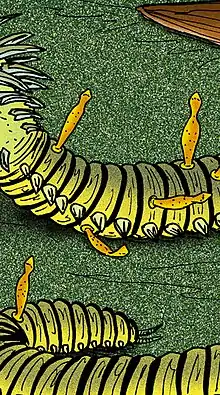Inquicus
Inquicus fellatus is an extinct, bowling pin-shaped worm from the Chengjiang Biota,[1] in what was once a marine environment from Early Cambrian Yunnan province. Its fossils are found attached to fossils of the worms Cricocosmia and Mafangscolex in either a parasitic or commensalistic relationship.
| Inquicus Temporal range: Early Cambrian | |
|---|---|
 | |
| Restoration of individuals on host, Cricocosmia sp. | |
| Scientific classification | |
| Kingdom: | |
| Phylum: | |
| Genus: | Inquicus |
| Binomial name | |
| Inquicus fellatus Cong, et al 2017[1] | |
Description
Inquicus individuals were up to three centimeters long, shaped like a bowling pin with an elongated body that tapered to a slightly bulbous head. They attached their bottom ends to their hosts, with their feeding appendages facing outwards and away from their hosts' bodies.[2]
Behavior
Although Inquicus attached to host worms, it is unlikely that the relationship was directly parasitic. The attachment point of Inquicus did not penetrate the skin of the hosts, but rather attached through suction. The species also was stiff, with there being no evidence that it could bend its mouth backwards to feed on the host. It is more likely that they simply rode on their hosts while browsing for food, or used them as a form of locomotion.[2]
References
- Peiyun Cong; Xiaoya Ma; Mark Williams; David J. Siveter; Derek J. Siveter; Sarah E. Gabbott; Dayou Zhai; Tomasz Goral; Gregory D. Edgecombe; Xianguang Hou (2017). "Host-specific infestation in early Cambrian worms". Nature Ecology & Evolution. 1 (10): 1465–1469. doi:10.1038/s41559-017-0278-4. hdl:2381/41401. PMID 29185506. S2CID 5564867.
- "Infested fossil worms show ancient example of symbiosis". www.nhm.ac.uk. Retrieved 2022-10-19.